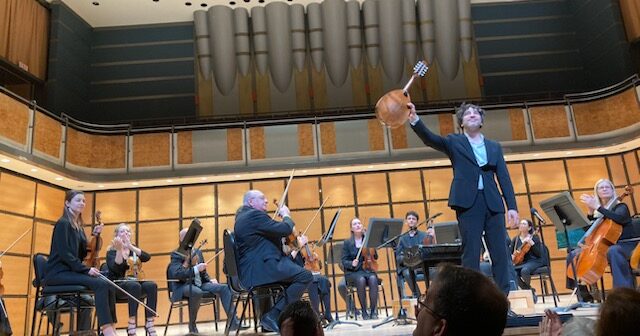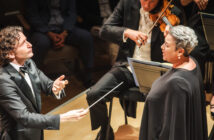The mandolin is not widely recognized as a regular component of classical music concerts, but in a recent concert in Toronto the Israeli mandolin virtuoso Avi Avital made the best possible case for his instrument. Avital was joined by about 20 string players from the Toronto Symphony for a richly rewarding program of Vivaldi and Bach concertos, along with a recent concerto written for him by Avner Dorman, at the George Weston Recital Hall in North York. A near-capacity audience seemed thrilled with what they heard.
The mandolin is historically a very old instrument but its role was mostly confined to folk and popular music. In concert life it was more likely to make an appearance in the form of a sister instrument such as the lute. But it does pop up from time to time. Vivaldi wrote only one concerto for the instrument – Avital played it at this concert – and Beethoven wrote a few short and inconsequential pieces for mandolin. Mahler included it in three of his works: the Seventh and Eighth symphonies and Das Lied von der Erde. But it plays only a few notes in each of these pieces and is usually all but inaudible. Prokofiev and Stravinsky also made use of it on occasion. But on the whole the mandolin remains an outlier as far as classical music is concerned.

Photo: www.aviavital.com
Then along comes a virtuoso like Avi Avital and suddenly attention must be paid. What he can do with a mandolin must be heard to be believed. He can make it sing and dance; he can make it laugh and cry. And he can put together an entire concert featuring the mandolin that is both serious and entertaining.
Avital began his concert with his own arrangement of Vivaldi’s Lute Concerto in D major RV93. The mandolin is basically a quiet instrument and is easily drowned out by other instruments. Avital used a microphone and amplifier to improve on nature and the balance with the string orchestra was perfect. The mandolin was not turned into an ear-splitting rock instrument but carefully calibrated to be primus inter pares, as it were. In this concerto and throughout the concert Avital was both soloist and conductor and did wonderful work in both capacities. And the TSO strings led by concertmaster Mark Skazinetsky accompanied with the utmost sensitivity. The continuo work by principal cellist Joseph Johnson and harpsichordist Christopher Bagan was also first-rate.
Next came Bach’s Violin Concerto in G minor BWV 1056R, also arranged by Avital. There were times when one missed the sustaining power of the violin. But on the whole the arrangement worked well.
Avner Dorman was born in Israel and studied at Juilliard, and is now Associate Professor of Music Theory and Composition at Gettysburg College in Pennsylvania. In 2005 Avital asked Dorman to write a concerto for him and the composer produced a work that shows off the mandolin to great advantage, and more importantly, a piece that is both highly original and wholly successful. One of the mandolin’s most familiar characteristics is the frequent use of tremolo, or repeated notes. Dorman makes use of this effect to start and end the concerto, not only in the solo instrument but also in the accompanying strings. Dorman also reminds us that the mandolin has often been used in bluegrass music and on a sister instrument like the oud, in Middle Eastern music. The last section has a decidedly Middle Eastern flavour with a haunting duet between mandolin and solo viola beautifully played by Theresa Rudolph.
After intermission Avital switched to somewhat lighter fare, in two suites drawn from folk sources. The first was Six Miniatures on Georgian Folk Themes, originally composed by Sulkan Tsintsadze for string quartet. Avital transcribed them for mandolin and string orchestra. This is music of toe-tapping rhythmic verve alternating with moments of aching sadness, all played with total commitment by Avital and the TSO. Finally, we heard Bartók’s Romanian Folk Dances, again arranged by Avital and played with artistry and joy.

Photo: Paul E. Robinson
The North York audience demanded an encore and got one: a Bulgarian folk song played by Avital alone and featuring quite astonishing virtuosity.
Avital plays a mandolin built in 1998 by the Israeli luthier Arik Kerman. The mandolin is a small instrument compared to the lute or the guitar. It has frets like the guitar and steel strings, usually four courses of doubled strings tuned like a violin. It is played with a pick rather than the fingers as in the case of an acoustic guitar. In the hands of an artist like Avital it is capable of playing lyrical melodies, chords, rapid passages and exciting strumming effects. Avital also demonstrated that the instrument is capable of yielding up a wide variety of tone colours using both left and right-hand techniques.
Avi Avital is an exclusive Deutsche Grammophon artist and at last count had made 6 CDs for the company. You can check them out at www.aviavital.com.
For many years now the TSO has been giving a regular series of concerts at George Weston Recital Hall. Let’s hope the tradition continues. This hall has wonderful acoustics and convenient parking, and saves North York music-lovers the trouble of battling traffic or transit uncertainties to get to Roy Thomson Hall.
















